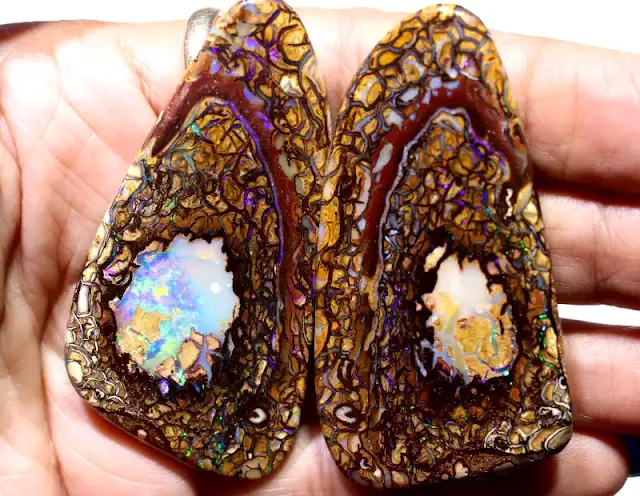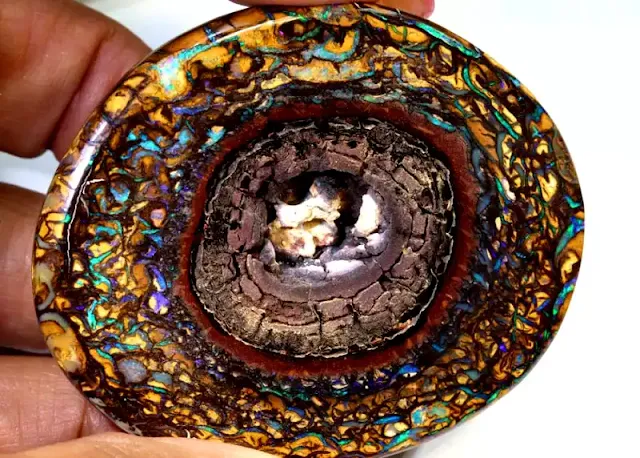Yowah Nut Opal
Yowah Nut Opals are a distinctive variety of precious opal found exclusively in the Yowah Opal Field of southwestern Queensland, Australia. These opals form within ironstone nodules—rounded concretions that resemble nuts in shape and size, typically measuring between 0.2 inches (5mm) to 8 inches (200mm) in diameter.
The opal material is either embedded within these nodules or fills cavities within them, hidden beneath an unassuming ironstone exterior. To access the gemstone, miners crack or slice the nodules open, revealing vibrant opalescent patterns of red, green, blue, and purple.
Originating from weathered volcanic ash deposits, Yowah Nut Opals are prized for their striking play-of-color and intricate formations. However, their allure is matched by their rarity: estimates suggest only 1 in 1,000 nodules contains opalized material, while a fully opalized "eye kernel" center—a prized specimen—is found in just 1 in 10,000 cases. This unpredictability, combined with the contrast between their earthy ironstone matrix and luminous interior, makes Yowah Nut Opals highly sought after by collectors, jewelers, and gemstone enthusiasts worldwide.
 |
Rare Yowah Nut Opal specimens with fiery color patterns. |
How Yowah Nut Opal Forms
The development of Yowah nut opals is the result of a sequence of geological processes that occurred over millions of years:
Formation of Ironstone Concretions:
Initially, iron-rich sediments accumulated in a sedimentary environment. These sediments gradually compacted and lithified to form ironstone concretions.
Weathering and Erosion:
As environmental conditions changed—such as the regression of marine influences and a shift toward a drier climate—the ironstone concretions were exposed to weathering and erosion. This exposure led to the development of cracks and fissures in the ironstone.
Infiltration of Silica-Rich Waters:
During periods of increased moisture, water enriched with dissolved silica infiltrated the cracks. This silica-laden water, sourced from groundwater or the weathering of nearby volcanic rocks, penetrated the ironstone, filling void spaces within the concretions.
Opal Deposition:
Under specific conditions of temperature, pressure, and chemical composition, the dissolved silica precipitated out of the solution and deposited as opal within the cavities of the ironstone. This process, which may form distinct layers and patterns, is responsible for the characteristic play-of-color seen in these opals.
Concretion Hardening:
Over time, the combined deposition of opal and the ongoing lithification of the ironstone resulted in the hardened, nut-like shape of the Yowah opals. Although there are occasional reports of organic material being encapsulated during this process, such occurrences are not widely documented and should be interpreted with caution.
Yowah Nut Opal Properties
Yowah opal nuts are truly unique creations, combining the rough charm of ironstone concretions with the dazzling beauty of precious opal. Let's delve into their captivating properties:
Appearance: Yowah nuts range in size from small pebbles to sizable spheres, typically between 5mm and 200mm. They have a rough, bumpy exterior formed by ironstone, often stained with brown, red, or yellow hues. Inside, the prized opal resides, showcasing a smooth, polished surface that can play host to a kaleidoscope of colors and patterns.
Composition: The outer shell is primarily composed of ironstone, a naturally occurring mixture of iron oxides and other minerals. The interior opal can be milk opal, black opal, boulder opal, or even display rare varieties like jelly opal or porcelain opal.
Hardness: The ironstone exterior boasts a hardness of 3-4 on the Mohs scale, while the opal within is 5-6.5, requiring careful handling to avoid scratches or fractures.
Play-of-color: This is the defining characteristic of Yowah opal, where flashes of vibrant rainbow colors dance across the opal's surface when moved under light. The play-of-color depends on the opal variety and can range from fiery reds and oranges to cool blues and greens.
Patterns: Yowah nuts often host stunning patterns within the opal, formed by the unique interplay of silica deposition and mineral inclusions. These patterns can resemble landscapes, lightning strikes, or even celestial bodies, adding to their mesmerizing beauty.
Transparency: The transparency of the opal within a Yowah nut can vary greatly. Milk opal tends to be opaque, while black opal might exhibit a translucent to semi-translucent quality. Other varieties like jelly opal can be nearly transparent, showcasing the mesmerizing play-of-color to its fullest.
 |
| Yowah Nut Opals from Queensland, Australia, showing vibrant play-of-color in red, blue, and green within ironstone concretions. |
Where to Find Yowah Nut Opal
Here's where you can find Yowah Opal Nuts
Main Location: The primary source of Yowah Opal Nuts is the Yowah opal fields in Western Queensland, Australia. Located approximately 850 km northwest of Brisbane, this region covers hundreds of square kilometers and holds the largest deposit of Yowah nuts in the world.
Other Locations: Although less common, small pockets of Yowah nuts have been found in other parts of Australia, including Lightning Ridge in New South Wales.
 |
| Yowah Nut Opal pair Photo by: Investmentopals |
Yowah Opal Nut Uses
Yowah Opal Nut, like other opals, is primarily used in the creation of jewelry due to its unique and vibrant play of colors. Here are some common uses for Yowah Opal Nut:
Jewelry: Yowah Opal Nuts are often cut and polished to showcase their stunning colors and patterns. They are then set into various types of jewelry, including rings, pendants, earrings, and bracelets. The opals can be used as centerpieces or accent stones in combination with other gemstones or metals.
Collectibles: Yowah Opal Nuts, with their distinctive shapes and mesmerizing colors, are often collected by enthusiasts and collectors. Some individuals appreciate these opals for their rarity, unique patterns, and the natural artistry encapsulated within the ironstone concretions.
Art and Sculptures: In addition to traditional jewelry uses, Yowah Opal Nuts can also be incorporated into artistic creations and sculptures. The unique play of colors and the natural shape of the opal within its ironstone matrix can inspire artistic expressions.
Investment: High-quality and rare Yowah Opal Nuts can be considered valuable and may appreciate in value over time. Some individuals choose to invest in opals, including those with unique formations like the Yowah Opal Nut, as part of a diversified gemstone portfolio.
Custom Designs: Jewelers and artisans may use Yowah Opal Nuts to create custom-designed pieces for clients who appreciate the uniqueness of these opals. The distinctive patterns and shapes of Yowah Opal Nuts can be integrated into one-of-a-kind jewelry designs.
Cultural and Spiritual Uses: In various cultures, gemstones, including opals, may have historical or spiritual significance. Some people believe that certain stones possess metaphysical properties, such as promoting creativity, enhancing intuition, or providing protection. Yowah Opal Nuts, with their unique characteristics, may be appreciated for such purposes.
 |
| Nut Opals split open to reveal precious opal veins in ironstone nodules. Photo: Investmentopals |
Yowah opal nuts are more than just rocks; they're natural works of art, encapsulating millions of years of geological history and dazzling beauty. Their unique combination of properties makes them highly sought-after by collectors, jewelers, and anyone captivated by the magic of the Earth's hidden treasures.



%20(1).webp)





